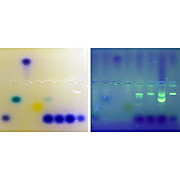G-Biosciences, Equipment
-
Gel Box Science Kit
G-BiosciencesThis Biotechnology Basics™ kit by Ellyn Daugherty is designed to teach the basic principles of a gel box, specifically horizontal agarose gel electrophoresis. The kit is supplied with all the reagents necessary to conduct 4 gel box science experiments, each using a gel box (not supplied). …
-
Microorganisms In Our Environment Kit
G-BiosciencesMicroorganisms, such as bacteria and fungi, are all around us. This kit allows students to collect samples from the world around them and grow the microorganisms so that students can visualize the microorganisms. This teaches students how to plate and grow microorganisms. …
-
Lowry Protein Assay Kit
G-BiosciencesDetermination of protein concentration is an essential technique in all aspects of protein studies and proteomics. The Assays for Protein Quantification kit includes three of the most widely used protein assays and allows for a direct comparison of the three assays that teaches students…
-
Polymerase Chain Reaction Kit
G-BiosciencesA comprehensive program that prepares adults and teenagers for a variety of post-secondary options including community or career college biotechnology certificate programs, four-year biotechnology degree programs, and industry workplaces. The vast text and laboratory curriculum was development…
-
Physical Properties of Proteins Kit
G-BiosciencesProteins are the building blocks of life and there are estimated to be almost 1 million different proteins in a normal animal cell. Each protein has very different and unique physical properties. The Physical Properties of Proteins kit is a lab activity that enables students to investigate…
-
How Clean Is Our Water Kit
G-BiosciencesWater pollution is a major problem throughout the world, raising severe concerns about health and sanitization issues. A common problem in polluted water is the presence of bacteria, particularly coliform bacteria from fecal matter, which can directly result in disease, as well as act as a…
-
This Biotechnology Basics™ by Ellyn Daugherty is designed to teach students the basic principles of measuring small volumes (<500µl) using micropipettes. The kit is supplied with all the reagents to allow 8 groups of 4 students to learn about P-1000, P-200 or P-100 and P-20 or P-10…
-
G-CAPSULE™
G-BiosciencesElectroelution of nucleic acids and proteins has many advantages as it avoids centrifugation, vortexing, heating, precipitation and allows minimal manipulation of samples. Electroelution normally involves dialysis tubing, which results in extreme dilution of precious samples. G-Capsule™ is a…
-
G-Trap™ FPLC Columns
G-BiosciencesG-Trap™ FPLC Columns are empty columns designed for fast protein liquid chromatography. G-Trap™ FPLC Columns are made of polypropylene and come in 1 ml and 5 ml sizes. Features: Column material: polypropylene (PP) Frit material: Ultra high…
-
Protein Electrophoresis Kit
G-BiosciencesAn important and essential tool in protein analysis is electrophoresis. Protein electrophoresis allows researchers to separate complex protein samples by their molecular size and/or net charge on polyacrylamide gels. The proteins can be subsequently visualized with various protein…
-
Hydrophobic and Hydrophilic Proteins Kit
G-BiosciencesRecent proteomic studies have led scientists to estimate that there are almost a million different proteins in a single human cell. The function and properties of these proteins are highly distinct ranging from structural proteins involved in cell integrity, including hydrophobic cell…
-
DNA Fingerprinting Kit
G-BiosciencesToday’s media routinely covers forensic stories of criminals captured and innocents released using the powerful DNA fingerprinting technique. This kit allows students to carry out their own criminal investigation by comparing DNA samples collected from suspects to DNA collected at a…
-
Assays for Protein Quantification Kit
G-BiosciencesDetermination of protein concentration is an essential technique in all aspects of protein studies and proteomics. The Assays for Protein Quantification kit includes three of the most widely used protein assays and allows for a direct comparison of the three assays that teaches…
-
Immunoaffinity Chromatography Kit
G-BiosciencesA hands on lab activity to study immunoaffinity chromatography and use a specific antibody to purify antigenic proteins from complex samples. This technique involves performing a chromatography procedure using antigen or antibody immobilized on a chromatographic resin. The solution…
-
Crime Scene DNA Analysis Kit
G-BiosciencesThis Biotechnology Basics™ kit by Ellyn Daugherty is designed to teach students about RFLP (restriction fragment length polymorphisms) and its use in crime scene investigations. Students will use restriction enzyme digestions of victim, suspect and crime scene DNA and then visualize the…
-
Zymography is an electrophoretic technique that includes a substrate copolymerised with the polyacrylamide gel for the detection of enzymes and their activity. Samples are prepared without denaturing the active enzymes present in the samples. Following electrophoresis, the gel is placed in an…
-
Dialysis Kit
G-BiosciencesDialysis is a routinely used technique in research laboratories to “change” the solution a biomolecule is dissolved in. Often the buffers used to isolate biomolecules, such as proteins, are not compatible with downstream applications due to high concentrations of reagents, such as…
-
Hydrophobic Chromatography Kit
G-BiosciencesHydrophobic chromatography is based on the fact that protein molecules can have extensive hydrophobic regions. These hydrophobic regions, in media favoring hydrophobic interactions, such as an aqueous solution with high salt concentration, can bind to hydrophobic ligands coupled to an…
-
Size Exclusion Chromatography Kit
G-BiosciencesSize exclusion chromatography (SEC), also called gel filtration chromatography or gel-permeation chromatography (GPC), uses porous particles to separate molecules of different sizes. It is generally used to separate biological molecules and to determine molecular weights and molecular weight…
-
Dot Blot Analysis Kit
G-BiosciencesThis lab activity teaches the use of highly specific matching properties of antigen-antibody for detection of antigenic or antibody proteins in complex samples. One such immunodetection method is widely known as Dot Blot. The method involves applying small volumes of antigens or test…
-
DNA Synthesis Kit
G-BiosciencesA comprehensive program that prepares adults and teenagers for a variety of post-secondary options including community or career college biotechnology certificate programs, four-year biotechnology degree programs, and industry workplaces. The vast text and laboratory curriculum was development…
-
Isolate your own Genomic DNA Kit
G-BiosciencesGenomic DNA isolation is a crucial technique in molecular biology, genetic manipulation and biotechnology. To carry out these exciting and innovative sciences, researchers require an original source of DNA, which is easy to acquire as it is found in every living organism. Genomic DNA is…
-
The rAmylase Project: Assaying for Amylase Activity Kit
G-BiosciencesThis kit is designed to teach 8 groups of four students the principles of enzyme assays. The kit contains the reagents to allow students to test for the presence and activity of 2 different types of amylase by: Visualizing the breakdown of the starch substrate by the amylase…
-
Plasmid Isolation (Alkaline Lysis) Kit
G-BiosciencesBacterial plasmids, the non-genomic transferable DNA, can easily be purified from bacteria using numerous techniques. The purification of DNA is important for genetic research as it provides a source of transferable DNA and allows researchers to isolate large amounts of recombinant DNA. …
-
Antibiotic Sensitivity & Bacteria Screening Kit
G-BiosciencesAntibiotics play a crucial role in the manipulation, screening and killing of bacteria in a range of biotechnology processes. This kit specifically teaches the basic principles of antibiotics, bacterial resistance and susceptibility. Students learn and understand the use of antibiotic…
-
G-Trap™ FliQ FPLC Columns
G-BiosciencesG-Biosciences present several empty low pressure chromatography columns. The columns and its parts are made of polypropylene which is chemically resistant to most of the commonly used reagents for chromatography. The end adaptors supplied with the column contain 10-32 UNF connections which are…
-
Isolation & Characterization of Bacteria Kit
G-BiosciencesAn interesting hands-on lab activity that teaches students the skills required for the isolation of bacteria from test samples. This kit teaches aseptic handling techniques and cultivation of bacteria. Using bacterial culture techniques, students discover and isolate the bacteria…
-
Introduction to Agarose Electrophoresis Kit
G-BiosciencesAgarose gel electrophoresis is a routinely used tool for separating nucleic acids. Nucleic acids are negatively charged molecules, which when loaded onto the solid agarose matrix, migrate in the presence of an electric field, separating the nucleic acids by size. …
-
This kit is designed to teach 8 groups of four students the principles of Western blotting. The kit contains the reagents to allow students to: Conduct a serial dilution of a stock amylase solution Prepare samples for PAGE electrophoresis Separate proteins by electrophoresis …
-
This kit is designed to teach 8 groups of four students the principles of Ion Exchange Chromatography and protein purification. The kit contains the reagents to allow students to: Equilibrate a DEAE agarose column Load a protein sample on the column (amylase, lysozyme or a mixture of…
-
Electroelution Kit
G-BiosciencesNucleic acids (DNA and RNA) and proteins are routinely resolved by electrophoresis, which separates molecules based on size and/or charge. Following electrophoresis, the molecules need to be extracted from the electrophoresis medium for use in downstream applications and experiments.…
-
Biuret Protein Assay Kit
G-BiosciencesDetermination of protein concentration is an essential technique in all aspects of protein studies and proteomics. The Assays for Protein Quantification kit includes three of the most widely used protein assays and allows for a direct comparison of the three assays that teaches…

























